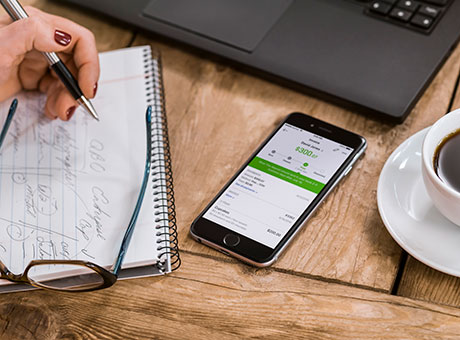As a self-employed person, it’s important to pay yourself a reasonable salary. Determining an adequate salary might take some intense thought, since entrepreneurs wear many hats. It’s also essential to consider the impact the salary you choose might have on your taxes. Not only do you have to figure out how much to pay yourself, but you must also determine how to do so. Do you plan to pay yourself a base salary or a percentage of sales? Will your income be in salary or dividends? These considerations and many others impact the amount of taxes you pay in the future.

Setting Your Salary as a Small Business Owner
How to Pay Yourself: Salary vs. Dividends
One of the most important decisions you must make as a small business owner is whether to pay yourself in salary or dividends. If you pay yourself a salary instead of dividends, you’re subject to higher tax payments, but you also have legally recognizable personal income. This allows you to save for retirement with involuntary Canada Pension Plan (CPP) and voluntary Registered Retirement Savings Plan (RRSP) contributions. You can also pay yourself through a payroll process, which means setting up a payroll account with the Canada Revenue Agency (CRA).
If you pay yourself through dividends, you avoid the mandatory retirement contribution rule. This gives you more flexibility in terms of your retirement plans. Unlike salary, dividends do not trigger CPP contributions. They also don’t count toward RRSP or salary calculations on loan applications, so you may have a harder time applying for a mortgage.
Due to the advantages and disadvantages of these methods, many business owners use a combination of both payment options. You can also set up a trust through a small business corporation and as the head of your family. The family trust can then legally become a shareholder of the corporation and receive dividends. The recipients of the trust have the advantage of reduced taxes due to exceptions and tax credits.
Calculate Your Salary With Your Budget
When you’re self-employed, thinking in terms of hourly wages when determining your salary isn’t too economical, because you probably work all the time. Instead, think in terms of a base salary or a percentage of sales. For example, if your primary job is generating leads, you can pay yourself a percentage of each sale. You can also refine your budget based on an incentive plan. Perhaps if you sell 10 widgets, you get a bonus of 10%, but if you sell 20 widgets, you get a bonus of 30%. As you fine-tune your own incentive strategy, do it with the intention of eventually hiring someone else to do the job. That is, think about what incentives you might put in place for someone to do your job effectively.
Perhaps the best way to determine how much you can pay yourself is by developing a budget. Your budget should be a living document that you reference often. Include a sales forecast and a cost of getting the work done to ensure you have a viable business model. Sometimes, the amount you pay yourself is simply dependent on what’s left after keeping the business running.
Paying Yourself: Start Small
When you’re first getting started, pay yourself enough to cover your basic living expenses. As your business grows, you can slow your rate of reinvestment and increase your salary. Creating a budget and adhering to it can greatly reduce the amount of stress that comes along with running a business, while creating a daily, weekly, or monthly budget can help ensure your own financial needs are also met.
Should I Withdraw or Reinvest Earnings?
As a business owner, you know reinvesting profits back into the company is important for business growth. But at the same time, you need to pay your bills. So what do you do? Should you pay yourself a salary, take withdrawals from your company, or reinvest your profits back into your business? There’s not one right answer. But by weighing the pros and cons of each option, it’s easy to determine a path that works best for you and your company.
Withdrawing Company Profits
It’s important to reinvest profits back into your business, but not if you are struggling to pay your personal bills. A lot of business owners assume that reinvesting their profits in their business is always the right thing to do. Then, when they need money, they simply withdraw some of the company’s profits. But this method of paying yourself can really backfire. If you aren’t careful, you could wind up paying taxes on the money you withdraw on both your personal and business taxes.
Paying Yourself a Salary
If you don’t have a substantial savings account you can use to foot your bills, consider paying yourself an annual salary — even if it’s a modest one. But your living expenses aren’t the only thing you should consider when it comes to taking a salary. Paying yourself a salary lets you show a legally recognizable personal income. Lenders need to see a personal income to approve you for loans, lines of credit, and credit cards. So if you plan to make any large purchases in the near future, opting for an annual salary is a good option.
On the downside, taxes are higher for self-employment salaries than they are for dividend payments. Also, when you pay yourself a salary, you have to go through the entire payroll process. This means you need to set up a payroll account with the CRA.
If you do pay yourself a salary, you need to put some thought into the amount you’re paid as well. To maximize your CPP benefit, you’re required to pay yourself a certain amount of money per year. For example, in 2018, you need an annual salary of at least a $55,900 to maximize your CPP benefits. The threshold is much higher to maximize your RRSP. It’s about $145,722 per year (in 2018) — you can contribute up to 18% of your annual income up to a maximum of $26,230.
Paying Yourself in Dividends
If you’re disciplined about saving for retirement on your own and have a good financial planner to help you invest properly, taking dividend payments instead of a salary might be a good option. When you take dividend payments, you eliminate the required CPP contribution. But you also don’t qualify for RRSP contributions, which is why you need to plan for retirement on your own.
Taking dividend payments also minimizes the amount of personal taxes you pay. It keeps the money with your company, which is what’s needed if you want your business to grow. But if you pay yourself in dividends, there’s one thing you need to watch closely: your company’s bottom line. Any corporation that profits more than $500,000 for the year loses its small business tax credits and must pay corporate tax to the CRA. Because of this, many small business owners opt to take a combination of a small salary and dividends rather than choosing one or the other.
Small Business Benefits of Paying Yourself a Salary
For unincorporated businesses, the CRA doesn’t tax your net income, or profit, and there aren’t deductions when you pull money from the business to pay yourself. When you’re a Canadian small business owner and file as a corporation, you can still pay yourself a salary, in dividends, or a mix of the two.
Contribute Toward Retirement: RRSP and CPP
Paying yourself a salary has a few benefits when it comes to your retirement savings. Automatic contributions for retirement savings are ideal for people who don’t have a regular financial planner or who have a difficult time saving for retirement on their own. Because you are making an income, depending on your age, you’re allowed to contribute to a RRSP. This is usually an option that is best for people in higher tax brackets because it means they can expect higher tax savings.
There are other options, such as a Tax Free Savings Account, for owners who earn a smaller income. And because an RRSP is pulled from your income, it reduces the amount of your taxable income. Additionally, you’re not taxed until you withdraw funds from the account. When you pay yourself a salary, you also contribute toward the CPP. This requirement is beneficial in the long run when you get ready to retire or if you become disabled. It provides a monthly pension dependent on how much and how long you contributed to the CPP.
Paying a Salary Can Help You Budget
Once you determine how much to pay yourself, you know how much income to expect regularly, making it easier to create a personal budget. Using a balance sheet, you can better manage your money and ensure you have enough to cover your monthly expenses. Having this monthly income is also important when you’re trying to get a mortgage for a home; it can become a complex process with a dividend since dividends don’t count toward earned income.
Your Salary Is a Business Tax Deduction
When you pay yourself a salary, the salary becomes a deduction for your small business corporation, although you are taxed personally on the income you receive. Dividends are paid out from the after-tax income of your business. If you have young children, having a salary also allows you to deduct childcare, which is not the case for the dividend alternative.
Because of the intricacies involved with the various ways you can pay yourself, it’s a decision that deserves careful consideration. Ultimately, it’s essential to choose a pay option that works well for you, your family, and your business. Make your decision with both your personal and business goals in mind. Then, before you set anything in stone, review your decision and the reasons behind it with your accountant to make sure you consider all the important angles.
Once you determine what’s right for your company, use accounting software to run your operation more efficiently. The QuickBooks Self-Employed app helps freelancers, contractors, and sole proprietors track and manage business on the go. Download the app.


